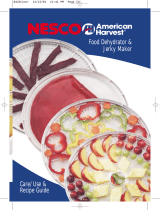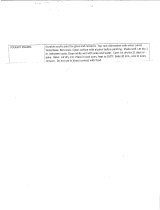14 1-800-288-4545
Drying
Place a Fruit Roll sheet on the dehydrator tray and wipe lightly with a vegetable oil
to prevent sticking. Purée should be about 1/4” to 3/8” thick and evenly spread.
Dry at 130
o
F – 140
o
F (55
o
C – 60
o
C) until fruit feels leather-like and is pliable, about 4
to 8 hours.
Storage
Remove the fruit roll while it is still warm, roll, cut into smaller size pieces (if desired)
and wrap in plastic wrap. Individually wrapped pieces of fruit leather should be
stored in larger airtight and moisture proof containers.
Fruit Drying Chart
Expect a variance in the time needed to dry different fruits. Drying times are
affected by the size of the load, fruit thickness and the moisture content of the food
itself. The guidelines are general. For more accurate drying times, keep records of
your own drying experiences.
Average
Food Preparation Drying Time Uses
Apples Pare, core, cut in 3/8" 4-10 hrs. Applesauce, pies,
Pre- treat cobblers, rings, snacks,
breads and cookies
Apricots Cut in half, remove 8-16 hrs. Desserts, muesli, meat
pit and cut in dishes, pies and sauces
quarters. Pre-treat
Bananas Peel, cut in 3/8" slices 6-12 hrs. Snacks, baby food,
or divide lengthwise granola, cookies, and
banana bread
Blueberries Wash and remove 10-18 hrs. Breads, baked goods,
stems. Dip in boiling snacks, ice cream, yogurt
water until skins crack.
Canned Drain well. If small, 6-12 hrs. Snacks, breads, granola
Fruit place on mesh screen.
Cherries Wash, remove stems 18-26 hrs. Breads, baked goods
and pit and snacks
Citrus Peel, if desired. 6-12 hrs. Flavorings when
Fruits Slice 3/8" thick powdered
Cranberries Wash and remove 10-18 hrs. Breads, baked goods,
stems. Dip in boiling snacks ice cream, yogurt
water until skins crack.
Coconut Remove dark outer 3-8 hrs. Cakes, cookies,
skin, slice 3/8" thick. desserts and granola





















